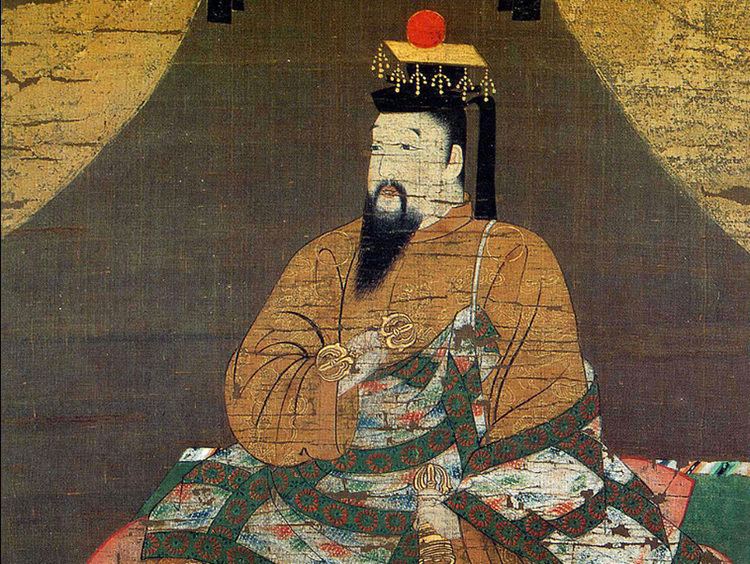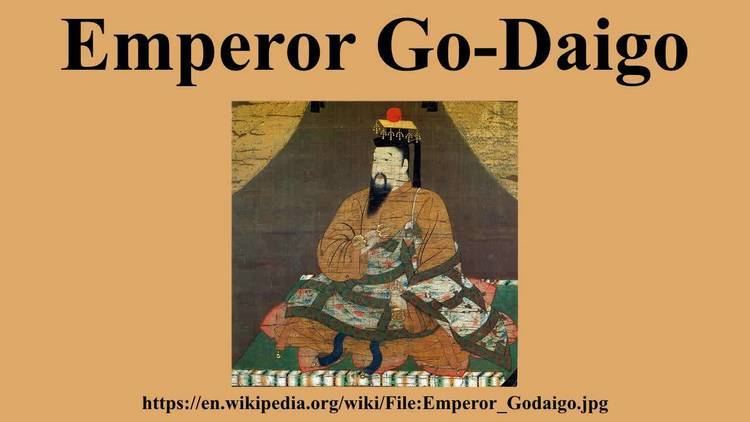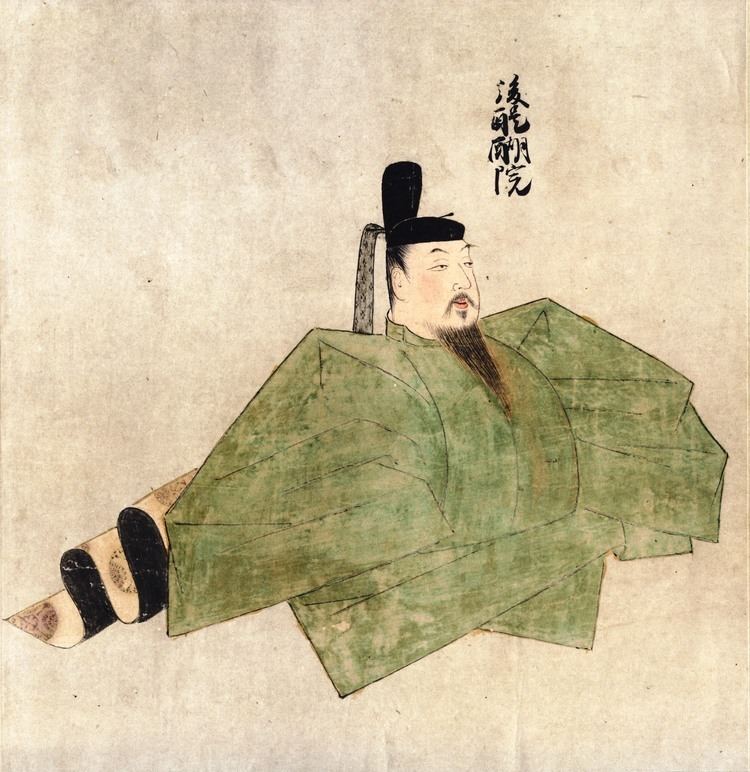Name Emperor Go-Daigo Successor Go-Murakami Role Sovereign | Father Go-Uda Parents Emperor Go-Uda Mother Fujiwara no Chushi | |
 | ||
Burial To-no-o no misasagi (Nara) Children Prince Moriyoshi, Emperor Go-Murakami, Prince Narinaga Grandchildren Emperor Chokei, Emperor Go-Kameyama Similar People | ||
Emperor go daigo
Emperor Go-Daigo (後醍醐天皇 Go-Daigo-tennō) (November 26, 1288 – September 19, 1339) was the 96th emperor of Japan, according to the traditional order of succession.
Contents
- Emperor go daigo
- Biography
- Events of Go Daigos life
- Consorts and children
- Kugy
- Eras of Go Daigos reign
- In popular culture
- References

Post-Meiji historians construe Go-Daigo's reign to span 1318–1339; however, pre-Meiji accounts of his reign considered the years of his reign to encompass only between 1318–1332. Pre-Meiji scholars also considered Go-Daigo a pretender emperor in the years from 1336 through 1339.

This 14th-century sovereign was named after the 9th-century Emperor Daigo and go- (後), translates as "later", and he is thus sometimes called the "Later Emperor Daigo", or, in some older sources, "Daigo, the second" or as "Daigo II".
Biography
Before his ascension to the Chrysanthemum Throne, his personal name was Takaharu-shinnō (尊治親王).
He was the second son of the Daikakuji-tō emperor, Emperor Go-Uda. His mother was Fujiwara no Chūshi/Tadako (藤原忠子), daughter of Fujiwara no Tadatsugu (Itsutsuji Tadatsugu) (藤原忠継/五辻忠継). She became Nyoin called Dantenmon-in (談天門院).
Emperor Go-Daigo's ideal was the Engi era (901–923) during the reign of Emperor Daigo, a period of direct imperial rule. An emperor's posthumous name was normally chosen after his death, but Emperor Go-Daigo chose his personally during his lifetime, to share it with Emperor Daigo.
Events of Go-Daigo's life
Emperor Go-Daigo became emperor at the age of 31.
In 1324, with the discovery of Emperor Go-Daigo's plans to overthrow the Kamakura shogunate, the Rokuhara Tandai disposed of his close associate Hino Suketomo in the Shōchū Incident.
In the Genkō Incident of 1331, Emperor Go-Daigo's plans were again discovered, this time by a betrayal by his close associate Yoshida Sadafusa. He quickly hid the Sacred Treasures in a secluded castle in Kasagiyama (the modern town of Kasagi, Sōraku District, Kyōto Prefecture) and raised an army, but the castle fell to the Shogunate's army the following year, and they enthroned Emperor Kōgon, exiling Daigo to Oki Province (the Oki Islands in modern-day Shimane Prefecture), the same place to which Emperor Go-Toba had been exiled after the Jōkyū War of 1221.
In 1333, Emperor Go-Daigo escaped from Oki with the help of Nawa Nagatoshi and his family, raising an army at Funagami Mountain in Hōki Province (the modern town of Kotoura in Tōhaku District, Tottori Prefecture). Ashikaga Takauji, who had been sent by the shogunate to find and destroy this army, sided with the emperor and captured the Rokuhara Tandai. Immediately following this, Nitta Yoshisada, who had raised an army in the east, laid siege to Kamakura. When the city finally fell to Nitta, Hōjō Takatoki, the shogunal regent, fled to Tōshō temple, where he and his entire family committed suicide. This ended Hōjō power and paved the way for a new military regime.
Upon his triumphal return to Kyoto, Daigo took the throne from Emperor Kōgon and began the Kenmu Restoration. The Restoration was ostensibly a revival of the older ways, but, in fact, the emperor had his eye set on an imperial dictatorship like that of the emperor of China. He wanted to imitate the Chinese in all their ways and become the most powerful ruler in the East. Impatient reforms, litigation over land rights, rewards, and the exclusion of the samurai from the political order caused much complaining, and his political order began to fall apart. In 1335, Ashikaga Takauji, who had travelled to eastern Japan without obtaining an imperial edict in order to suppress the Nakasendai Rebellion, became disaffected. Daigo ordered Nitta Yoshisada to track down and destroy Ashikaga. Ashikaga defeated Nitta Yoshisada at the Battle of Takenoshita, Hakone. Kusunoki Masashige and Kitabatake Akiie, in communication with Kyoto, smashed the Ashikaga army. Takauji fled to Kyūshū, but the following year, after reassembling his army, he again approached Kyōto. Kusunoki Masashige proposed a reconciliation with Takauji to the emperor, but Go-Daigo rejected this. He ordered Masashige and Yoshisada to destroy Takauji. Kusunoki's army was defeated at the Battle of Minatogawa.
When Ashikaga's army entered Kyōto, Emperor Go-Daigo resisted, fleeing to Mount Hiei, but seeking reconciliation, he sent the imperial regalia to the Ashikaga side. Takauji enthroned the Jimyōin-tō emperor, Kōmyō, and officially began his shogunate with the enactment of the Kenmu Law Code.
Go-Daigo escaped from the capital in Jan. 1337, the regalia that he had handed over to the Ashikaga being counterfeit, and set up the Southern Court among the mountains of Yoshino, beginning the Period of Northern and Southern Courts in which the Northern Dynasty in Kyōto and the Southern Dynasty in Yoshino faced off against each other.
Emperor Go-Daigo ordered Imperial Prince Kaneyoshi to Kyūshū and Nitta Yoshisada and Imperial Prince Tsuneyoshi to Hokuriku, and so forth, dispatching his sons all over, so that they could oppose the Northern Court.
The actual site of Go-Daigo's grave is settled. This emperor is traditionally venerated at a memorial Shinto shrine (misasagi) at Nara.
The Imperial Household Agency designates this location as Go-Daigo's mausoleum. It is formally named Tō-no-o no misasagi.
Consorts and children
Empress (Chūgū): Saionji Kishi (西園寺禧子) (Go-Kyōgoku-in, 後京極院) (1303–1333), daughter of Saionji Sanekane (西園寺実兼)
Empress (Chūgū): Imperial Princess Junshi (珣子内親王) (Shin-Muromachi-in, 新室町院) (1311–1337), daughter of Emperor Go-Fushimi
Nyōgo: Fujiwara no Eishi (藤原栄子), daughter of Nijō Michihira
Court lady: Minamoto no Chikako (源親子), daughter of Kitabatake Morochika (北畠師親)
Court lady: Fujiwara no Ishi/Tameko (藤原為子) (?–1311/2), daughter of Nijō Tameyo (二条為世)
Court lady: Ichijō no Tsubone (一条局), daughter of Saionji Sanetoshi (西園寺実俊)
Court lady: Fujiwara no Renshi (Ano Renshi) (藤原廉子/阿野廉子) (Shin-Taikenmon-in, 新待賢門院) (1301–1359), daughter of Ano Kinkado (阿野公廉)
Court lady: Gon-no-Dainagon no Sammi no Tsubone (権大納言三位局) (?–1351), daughter of Nijō Tamemichi (二条為道)
Princess: a daughter of Emperor Kameyama
Court lady: Shōshō no Naishi (少将内侍), daughter of Sugawara no Arinaka (菅原在仲)
Court lady: Fujiwara no Chikako (藤原親子), daughter of Kazan'in Munechika (花山院宗親)
Court lady: Fujiwara no Shushi/Moriko (藤原守子), daughter of Tōin Saneyasu (洞院実泰)
Court lady: Konoe no Tsubone (近衛局)
Court lady: Shōnagon no Naishi (少納言内侍), daughter of Shijō Takasuke (四条隆資)
Court lady: Gon-no-Chūnagon no Tsubone (権中納言局), daughter of Sanjō Kinyasu (三条公泰)
Court lady: Mimbu-kyō no Tsubone (民部卿局)
(unknown women)
Go-Daigo had some other princesses from some court ladies.
Kugyō
Kugyō (公卿) is a collective term for the very few most powerful men attached to the court of the Emperor of Japan in pre-Meiji eras. Even during those years in which the court's actual influence outside the palace walls was minimal, the hierarchic organization persisted.
In general, this elite group included only three to four men at a time. These were hereditary courtiers whose experience and background would have brought them to the pinnacle of a life's career. During Go-Daigo's reign, this apex of the Daijō-kan included:
Eras of Go-Daigo's reign
The years of Go-Daigo's reign are more specifically identified by more than one era name or nengō. Emperor Go-Daigo's eight era name changes are mirrored in number only in the reign of Emperor Go-Hanazono, who also reigned through eight era name changes.
Pre-Nanboku-chō courtIn popular culture
Emperor Go-Daigo appears in the alternate history novel Romanitas by Sophia McDougall.
